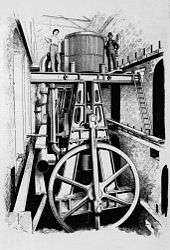Mount Crosby Pumping Station
The Mount Crosby Pumping Station is located on the Brisbane River in the City of Brisbane, Queensland, Australia. It is located on both sides of the river at Mount Crosby on the east bank and at Chuwar on the west bank. The facility supplies water to Brisbane and nearby cities and towns within the SEQ Water Grid. It is listed on the Brisbane Heritage Register.[1]

History
Brisbane's water supply during the convict era came from a reservoir in present-day Tank Street in the Brisbane central business district. There was no pipe network; the water was delivered by water carts to households who stored their water in barrels. The water was described as having "a pea-soup colour and consistency" which required the householders to add wood ashes or alum to their water barrels to precipitate the yellow sediments.[2] On establishment of the Brisbane Municipal Council in 1859, one of their first tasks was to plan a better water supply for the growing town.[3]
The Mount Crosby pumping station was originally steam-powered. Coal was transported via a tramway to fire the boilers to create the steam that drove the pumping engines; the tramway was originally created for construction purposes.[4] The facility originally pumped untreated water from the north or eastern bank of the River. To cater for increased demand the Westbank Water Treatment Plant was built in 1986.[5]
During January 2013 Eastern Australia floods, both treatment plants were unable to process Brisbane River water because it was too muddy and filled with silt.[6]
Geography
There is a single lane bridge over the Mount Crosby Weir enabling easy access between the two sites; it is also a public road.
Operation
Most of the water treated is sourced from Lake Wivenhoe and Lockyer Creek via the Brisbane River, though some is also from Lake Manchester.[7]
There are two intakes pipes, one on each bank.[5] The pipes are protected by a 25 millimetres (0.98 in) mesh screen which stops material such as leaves and sticks from entering the plant. The water from the Pumping Station is supplied to the Eastbank Water Treatment Plant. An additional smaller pumping station sits on the west bank to supply the Westbank Water Treatment Plant. Treated water from both Water Treatment Plants is pumped to two 90 megalitres (3.2×106 cu ft) reservoirs at Cameron's Hill.[5]
Westbank Water Treatment Plant is able to generate 250 megalitres (8.8×106 cu ft) of drinking water each day.[5] During periods of high demand the amount can be increased four-fold to 1,000 megalitres (35×106 cu ft). The process takes about 24 hours to convert.
Eastbank Water Treatment Plant is able to generate 850 megalitres (30×106 cu ft) of drinking water each day.
References
- "Mt Crosby Pumping Station". Brisbane Heritage Register. Brisbane City Council.
- "History of Moreton Bay Convict Settlement and Penal Colony". www.brisbanehistory.com. Archived from the original on 24 September 2015. Retrieved 13 September 2015.
- Melton, Charles (1 January 1935), Brisbane's water supply : the Queen Street fire of 1864, Royal Historical Society of Queensland, retrieved 13 September 2015
- "Mount Crosby". Queensland Places. Centre for the Government of Queensland, University of Queensland. Archived from the original on 8 October 2012. Retrieved 21 March 2013.
- "Mount Crosby Water Treatment Plant Tour" (PDF). Seqwater. Archived from the original (PDF) on 11 April 2013. Retrieved 21 March 2013.
- Tony Moore (30 January 2013). "Enough water for now - if we're careful". Brisbane Times. Fairfax Media. Archived from the original on 31 January 2013. Retrieved 21 March 2013.
- Lake Manchester joins SEQ drought fight Archived 8 June 2009 at the Library of Congress Web Archives. Brisbane City Council.
External links
| Wikimedia Commons has media related to Mount Crosby Pumping Station. |
- History of Mt Crosby via the Wayback Machine